Drake G.W.F. (editor) Handbook of Atomic, Molecular, and Optical Physics
Подождите немного. Документ загружается.


Parity Nonconserving Effects in Atoms 29.3 Many-Body Perturbation Theory 451
29.2 PNC in Cesium
We concentrate on PNC in cesium because it is the sim-
plest atom in which the effect has been measured. This is
because it consists of a single electron outside a closed
xenonlike core which is relatively unpolarizable. This
should be contrasted with, for example, thallium. While
thallium nominally also consists of one 6p
1/2
electron
outside a closed core, part of that core is a filled 6s
2
1/2
subshell. It is quite easy to polarize the outer subshell,
so that one really has three electrons outside a closed
core. This leads to distinctly poorer convergence prop-
erties of many-body perturbation theory, the theoretical
method used for these calculations, and consequently
less accurate atomic theory predictions. Similar consid-
erations apply to lead and bismuth. The PNC transition
in cesium that has been studied is 6s
1/2
→ 7s
1/2
,and
accurate measurements have been made in Paris [29.2]
and Boulder [29.3, 4]. Cesium is a 55 electron atom
with a nucleus consisting of 78 neutrons and 55 protons
with nuclear spin I = 7/2. The total angular momen-
tum of atomic s-states is then F = 3orF = 4. Both
of the transitions, 6s
1/2
(F = 4) → 7s
1/2
(F = 3) and
6s
1/2
(F = 3) → 7s
1/2
(F = 4), have been measured, al-
lowing the isolation of PNC effects that depend on the
spin of the nucleus. The bulk of atomic PNC comes
from the timelike contribution of the (V
N
A
e
) exchange
discussed in the previous section, and can be described
by the effective Hamiltonian
H
W
=
G
F
√
8
Q
W
ρ
nuc
(r)γ
5
. (29.5)
Here ρ
nuc
(r) is a weighted average of the neutron and
proton distributions in the nucleus, which leads to nu-
clear structure uncertainties that will be discussed below.
Using this Hamiltonian, a large scale calculation [29.10]
leads to the prediction for the nuclear-spin-independent
part of the PNC transition
E
PNC
=−0.905(9) ×10
−11
i|e|a
0
(−Q
W
/N).
(29.6)
Here the unknown Q
W
has been factored out and di-
vided by its approximate value −N. This result is
in good agreement with independent MBPT calcula-
tions of the Novosibirsk [29.12] and Göteborg [29.13]
groups. When this is compared with the experimental
measurement [29.3,4]
E
exp
PNC
=−0.8374(67) ×10
−11
i|e|a
0
,
(29.7)
there results a prediction for Q
W
of
Q
W
=−72.17(0.58)[0.72], (29.8)
where the first error is experimental and the second the-
oretical. The spacelike part of (V
N
A
e
) exchange and the
timelike part of (A
N
V
e
) exchange are negligible, but the
spacelike part of the latter gives a nuclear spin-dependent
effect that will be discussed below. Also discussed below
is an interesting nuclear physics source of PNC known as
the anapole moment [29.14], which arises from photon
exchange with weak radiative corrections on the nuclear
vertex. This effect enters at the several percent level, but
in a way that can be subtracted out as will be described
below.
29.3 Many-Body Perturbation Theory
While there are a variety of ways of solving the
many-electron Schrödinger equation, the most accurate
treatments of cesium PNC are based on many-body per-
turbation theory (MBPT). In MBPT, the Hamiltonian is
broken up into H = H
0
+V
C
,where
H
0
=
N
i=1
α
i
· p
i
+β
i
m +U(r
i
)
(29.9)
and
V
C
=
1
2
ij
α
|r
i
−r
j
|
−
N
i=1
Zα
r
i
+U(r
i
)
.
(29.10)
The starting potential U(r) is generally chosen to be
a frozen core Hartree–Fock (HF) potential. This model
of the atom is rather inaccurate: valence removal ener-
gies disagree with experiment by about 10%, and matrix
elements of the hyperfine operator by about 40%. Thus
it is essential for accurate calculations to include the
effects of V
C
as fully as possible. MBPT proceeds by
expanding the many-body wave function and the energy
in powers of V
C
. While going to second order in V
C
im-
proves agreement with experiment to the percent level
for energies and the few percent level for matrix ele-
ments [29.15], more powerful methods that sum infinite
classes of MBPT contributions are needed for higher ac-
Part B 29.3

452 Part B Atoms
curacy, and we turn to a description of these all order
methods.
If the frozen-core HF wave function is denoted by
Ψ
0
, all-order singles–doubles methods add to it a correc-
tion ∆Ψ with either one or two orbitals in the HF wav e
function excited:
δΨ =
am
ρ
ma
a
†
m
a
a
+
abmn
ρ
mnab
a
†
m
a
†
n
a
a
a
b
+
m
ρ
mv
a
†
m
a
v
+
amn
ρ
mnav
a
†
m
a
†
n
a
a
a
v
Ψ
0
.
(29.11)
The terms on the first line of (29.11) describe single and
double excitations of the closed core, while those on
the second line describe single and double excitations
of the atom where the valence orbital is also excited.
Substituting (29.11) into the Schrödinger equation, one
obtains a set of coupled equations for the expansion co-
efficients that can be found in [29.16]. The first and
second iterations of the equations for the expansion co-
efficients leads to results that are identical to first- and
second-order perturbation theory. In third-order pertur-
bation theory, terms associated with triple excitations
contribute to the energy. These terms have no coun-
terpart in the iterative solution to the equations under
consideration.
To account for such terms, it is necessary to add
to ∆Ψ a triple-excitation correction of the specific
form:
∆Ψ =
abcmnr
ρ
mnrabc
a
†
n
a
†
m
a
†
r
a
a
a
b
a
c
+
abmnr
ρ
mnrabv
a
†
n
a
†
m
a
†
r
a
a
a
b
a
v
Ψ
0
. (29.12)
Such a term enters in two ways. First, there are a set
of equations giving the triple-excitation coefficients in
terms of the single-, double-, and triple-excitation coef-
ficients. Second, the triple-excitation coefficients enter
on the right-hand side of the equations for the single-
and double-excitation coefficients. Solving for the triple-
excitation coefficients in terms of the singles and doubles
(ignoring the triples on the right-hand sides of these
equations), one can use them on the right-hand sides
of the equations for the singles. This procedure leads
to equations which, when iterated to third order, in-
clude all of the terms from MBPT. However, the triples
also modify the the doubles equation, and this more
computationally demanding step has not yet been imple-
mented. As the effects of this modification enter first in
fourth-order MBPT, the calculation is complete through
third order, but still misses some fourth-order contribu-
tions. Nevertheless, the method is accurate enough to
predict PNC to 1%. Greater accuracy is expected when
the doubles equation is modified, which should lead to
a calculation complete through fourth order, and work
on this problem is in progress.
29.4 PNC Calculations
The above discussion of MBPT allows the calculation
on cesium to be accurate to a few tenths of percent for
energies and under one percent for ‘ordinary’ matrix
elements [29.16], and thus should allow a calculation of
similar accuracy for PNC. To calculate such transitions,
one modifies H
0
by adding the weak-interaction h
W
to
the HF potential. This approach leads to a generalization
of the single-particle states in which each state acquires
an opposite-parity admixture, that is,
φ
k
→ φ
k
+
˜
φ
k
. (29.13)
Thus, for example, each s
1/2
orbital will pick up a small
p
1/2
state admixture. One can then calculate a PNC
transition along the lines of a parity allowed transi-
tion calculation, simply replacing each orbital occuring
in the MBPT formulas in turn with its opposite par-
ity admixture. Details of this approach can be found
in [29.10].
There are a number of smaller effects that must be
considered when the 1% level of accuracy is reached.
The first stems from the fact that the Z couples to the
density of up and down quarks, which in turn is related
to the density of protons and neutrons in the cesium
nucleus. While experimental data is available on the
charge distribution [29.17], the neutron distribution is
available only theoretically. While this uncertainty can
be shown to be unimportant for Cs
133
[29.10], there
has been interest in looking at PNC in several different
isotopes with the aim of taking ratios and greatly reduc-
ing atomic physics uncertainties. However, the neutron
distribution in different nuclei is more uncertain, and tak-
ing the ratio enhances the nuclear physics uncertainty.
This issue has been addressed recently by Chen and
Vogel [29.18], who estimate the nuclear physics uncer-
tainties to be smaller than the anticipated experimental
error.
Part B 29.4

Parity Nonconserving Effects in Atoms 29.6 Comparison with Experiment 453
The next small effect is the interaction between the
nuclear axial-vector current and the electron vector cur-
rent from Z exchange. In the limit of nonrelativistic
nucleon motion, this interaction is given by the spin-
dependent Hamiltonian
h
(2)
W
=−
G
√
2
K
2
κ −1/2
I(I +1)
α · Iρ(r).
(29.14)
Here, κ = 4, I = 7/2andK
2
−0.05 for the va-
lence proton of
133
Cs. Additionally, parity violation
in the nucleus leads to a parity-violating nuclear mo-
ment, the anapole moment mentioned above, that
couples electromagnetically to the atomic electrons. The
anapole–electron interaction is described by a Hamilto-
nian similar to (29.14), with K
2
replaced by −κ/(κ −
1/2)K
a
,whereK
a
= 0.24 −0.33 is determined from
nuclear model calculations [29.19]. Linear combina-
tions of amplitudes for different F → F
transitions
can be used to isolate either the spin-dependent or
spin-independent parts of the interaction. The final
smaller effects are Z exchange between the electrons,
which as mentioned above turns out to be negligi-
ble, and the inclusion of the Breit interaction. While
the original estimate of the latter was a small 0.2%
effect, included in (29.6), this turned out to be an un-
derestimate, one of a number of unexpectedly large
contributions found in recent years, as discussed in the
next section.
29.5 Recent Developments
The Breit interaction was reexamined by Dere-
vianko [29.20] and found to be significantly larger than
the 0.2% mentioned above . The 0.6% includes the ef-
fects of negative energy states, which are enhanced in
the context of PNC. This was followed by the dis-
covery of a number of effects that contributed at the
several tenths of a percent level, with theory and ex-
periment going into and out of agreement with one
another as each effect was found. At present the sit-
uation has stabilized, and, as will be discussed in the
next section, no discrepancy with the standard model
is present. In the past eight years, the principal de-
velopments have been the discovery of a surprisingly
large two-loop radiative correction associated with vac-
uum polarziation [29.21,22], recalculation of the atomic
physics part of the calculation [29.23], which, however,
only reduced the theoretical error bar, an independent
measurement of the polarizability of cesium [29.24],
and the discovery that the self-energy radiative correc-
tion, which in lowest order is −α/2π, and is included in
the radiative corrections to Q
W
presented in [29.11],
is strongly enhanced by binding corrections starting
at order Zα [29.25–27]. When taken together, these
different effects tend to cancel, so the qualitative pic-
ture of agreement with the standard model remains
correct.
29.6 Comparison with Experiment
We can now make use of the above analysis to extract
the value of the weak charge Q
W
from experiment. The
PNC amplitudes measured by Wieman et al. [29.3, 4]
are
(E
PNC
)
β
=
−1.6349(80) F = 4 → 3
−1.5576(77) F = 3 → 4
(29.15)
in units of mV/cm. The quantity β is the vector part of
the Stark induced polarizability for the 6s → 7s transi-
tion in cesium. This quantity has also been calculated
with an accuracy of better than 1% using the all-order
techniques outlined above, giving β =27.00(20)a
3
0
.We
note that this quantity can also be obtained from ex-
periment, but at present two recent experiments [29.3,
4, 24] are in disagreement, so we use the number ob-
tained from theory. Eliminating the spin-dependence
from (29.15), by taking an appropriate linear com-
bination and using the theoretical value for β, one
finds
E
exp
PNC
=−0.8252(184)[61]10
−11
|e|a
0
,
(29.16)
where the the first error is from experiment and the
second from theory. Combining this result with our
calculation of the spin-independent amplitude given
in (29.6), we obtain
Q
W
=−72.17(0.58)[0.72]. (29.17)
Alternatively, taking the opposite linear combination
to eliminate the spin-independent terms in (29.15), we
Part B 29.6

454 Part B Atoms
obtain the value
K
a
−(κ −1/2)/κK
2
= 0.72 ±0.10 (29.18)
for the constant governing the spin-dependent interac-
tion.
Radiative corrections to the weak charge Q
W
incor-
porating a parameterization of new physics beyond the
standard model have been worked out by Marciano and
Rosner [29.11], who find
Q
W
133
Cs
55
=−73.20 −0.8S−0.005T ±0.13 ,
(29.19)
assuming the values m
t
= 140 GeV for the top quark
mass and m
H
= 100 GeV for the Higgs particle mass.
The parameters S and T in (29.19) are associated partly
with deviations of the top quark and Higgs masses from
their assumed values and partly with new physics beyond
the standard model. In the absence of new physics, the
small factor multiplying T makes this prediction very
insensitive to the top quark mass. Unfortunately, both
the experimental and theoretical errors are presently
too large to make atomic PNC in cesium a precision
test of the standard model. However, there are two
features of cesium PNC that even at the present ac-
curacy lead to particle physics implications. The first
is the fact that large positive values of S, such as can
arise in technicolor theories [29.28], will lead to dis-
agreement of theory and experiment in cesium PNC.
The second is the effect of extra Z bosons, which is
not accounted for in (29.19). Exchange of new Z’s
can be shown to be strongly constrained by atomic
PNC [29.29]. Perhaps more interesting is the possibil-
ity of having entirely new physics that has not been
thought of. Since new physics affects different weak
interaction tests differently, it is important to have
as many such tests as possible. The value of atomic
PNC tests will increase when the next stage of ac-
curacy is reached, at which time atomic physics will
have a significant role in precision tests of the standard
model.
References
29.1 M. A. Bouchiat, C. C. Bouchiat: J. Phys. (Paris) 35,
899 (1974)
29.2 M. A. Bouchiat et al.: J. Phys. (Paris) 47, 1709 (1986)
29.3 S. C. Bennett, C. E. Wieman: Phys. Rev. Lett. 82,
2484 (1999)
29.4 C. S. Wood et al.: Science 275, 1759 (1997)
29.5 P. S. Drell, E. D. Commins: Phys. Rev. Lett. 53,968
(1984)
29.6 T. M. Wolfenden, P. E. G. Baird, P. G. H. Sandars:
Europhys. Lett. 15, 731 (1991)
29.7 T. P. Emmons, J. M. Reeves, E. N. Fortson: Phys.
Rev. Lett. 51, 2089 (1983)
29.8 M. J. D. Macpherson, K. P. Zetie, R. B. Warrington,
D. N. Stacey, J. P. Hoare: Phys. Rev. Lett. 67,2784
(1991)
29.9 W. Bernreuther, M. Suzuki: Rev. Mod. Phys. 63,313
(1991)
29.10 S. A. Blundell, J. Sapirstein, W. R. Johnson: Phys.
Rev. D 45, 1602 (1992)
29.11 W. Marciano, J. Rosner: Phys. Rev. Lett. 65,2963
(1990)
29.12 V. A. Dzuba, V. V. Flambaum, O. P. Sushkov: Phys.
Lett. A 141, 147 (1989)
29.13 A. C. Hartley, E. Lindroth, A.-M. Mårtensson-
Pendrill: J. Phys. B 23, 3417 (1990)
29.14 Ya. Zel’dovich: Zh. Eksp. Teor. Fiz. 33,1531
(1957) [Sov. Phys. JETP 6, 1184 (1958)]
29.15 W. R. Johnson, M. Idrees, J. Sapirstein: Phys. Rev.
A 35, 3218 (1987)
29.16 S. A. Blundell, W. R. Johnson, J. Sapirstein: Phys.
Rev. A 43, 3407 (1991)
29.17 R. Engfer et al.: At. Data Nucl. Data Tables 14,479
(1974)
29.18 B. Q. Chen, P. Vogel: Phys. Rev. C 48, 1392 (1993)
29.19 V. V. Flambaum, I. B. Khriplovich, O. P. Sushkov:
Phys. Lett. 146B,367(1984)
29.20 A. Derevianko: Phys. Rev. Lett. 85, 1618 (2000)
29.21 W. R. Johnson, I. Bednyakov, G. Soff: Phys. Rev.
Lett. 87, 233001 (2001)
29.22 W. R. Johnson, I. Bednyakov, G. Soff: Phys. Rev.
Lett. 88, 079903 (2002)
29.23 V. A. Dzuba, V. V. Flambaum, J. S. M. Ginges: Phys.
Rev. 66, 076013 (2002)
29.24 A. A. Vasilyev, I. M. Savukov, M. S. Safronova,
H. G. Berry: Phys. Rev. A 66, 020101 (2002)
29.25 M. Yu. Kuchiev: J. Phys. B 35, L503 (2002)
29.26 A. I. Milstein, O. P. Sushkov, I. S. Terekhov: Phys.
Rev. Lett. 89, 283003 (2002)
29.27 J. Sapirstein, K. Pachucki, A. Veitia, K. T. Cheng:
Phys. Rev. A 67, 052110 (2003)
29.28 M. E. Peskin, T. Takeuchi: Phys. Rev. Lett. 65,964
(1990)
29.29 P. Langacker, M. Luo: Phys. Rev. D 45,278
(1992)
Part B 29

455
Atomic Clocks
30. Atomic Clocks and Constraints on Variations
of Fundamental Constants
Fundamental constants play an important role in
modern physics, being landmarks that designate
different areas. We call them constants, however,
as long as we only consider minor variations
with the cosmological time/space scale, their
constancy is an experimental fact rather than
a basic theoretical principle. Modern theories
unifying gravity with electromagnetic, weak,
and strong interactions, or even the developing
quantum gravity itself often suggest such
variations.
Many parameters that we call fundamental
constants, such as the electron charge and
mass [30.1, 2], are actually not truly fundamental
constants but effective parameters which are
affected by renormalization or the presence of
matter [30.3]. Living in a changing universe
we cannot expect that matter will affect these
parameters the same way during any given
cosmological epoch. An example is the inflationary
model of the universe which states that in
a very early epoch the universe experienced
a phase transition which, in particular, changed
a vacuum average of the so-called Higgs field
which determines the electron mass. The latter
was zero before this transition and reached
a value close or equal to the present value after
the transition.
The problem of variations of constants has
many facets and here we discuss aspects related
to atomic clocks and precision frequency
30.1 Atomic Clocks and Frequency Standards. 456
30.1.1 Caesium Atomic Fountain ........... 456
30.1.2 Single-Ion Trap ......................... 457
30.1.3 Laser-Cooled Neutral Atoms ....... 457
30.1.4 Two-Photon Transitions
and Doppler-Free Spectroscopy... 458
30.1.5 Optical Frequency Measurements 458
30.1.6 Limitations on Frequency
Variations ................................ 458
30.2 Atomic Spectra and their Dependence on
the Fundamental Constants.................. 459
30.2.1 The Spectrum of Hydrogen
and Nonrelativistic Atoms .......... 459
30.2.2 Hyperfine Structure
and the Schmidt Model.............. 459
30.2.3 Atomic Spectra:
Relativistic Corrections ............... 460
30.3 Laboratory Constraints
on Time the Variations
of the Fundamental Constants.............. 460
30.3.1 Constraints from Absolute Optical
Measurements .......................... 460
30.3.2 Constraints from Microwave
Clocks ...................................... 461
30.3.3 Model-Dependent Constraints .... 461
30.4 Summary ............................................ 462
References .................................................. 462
measurements. Other related topics may be found
in [30.4].
Laboratory searches for a possible time variation of fun-
damental physical constants currently consist of two
important parts: (i) one has to measure a certain phys-
ical quantity at two different moments of time that are
separated by at least a few years; (ii) one has to be able
to interpret the result in terms of fundamental constants.
The latter is a strong requirement for a cross comparison
of different results.
The measurements which may be performed most
accurately are frequency measurements; and thus,
frequency standards or atomic clocks will be in-
volved in most of the laboratory searches. Frequency
metrology has shown great progress in the last
decade and will continue to do so for some time.
The constraints on the variations of the fundamen-
tal constants obtained in this manner are, so far,
somewhat weaker than those from other methods (as-
trophysics, geochemistry), but still competitive with
them. In contrast to other methods, however, fre-
quency measurements allow a very clear interpretation
of the final results and a transparent evaluation pro-
cedure, making them less vulnerable to systematic
Part B 30
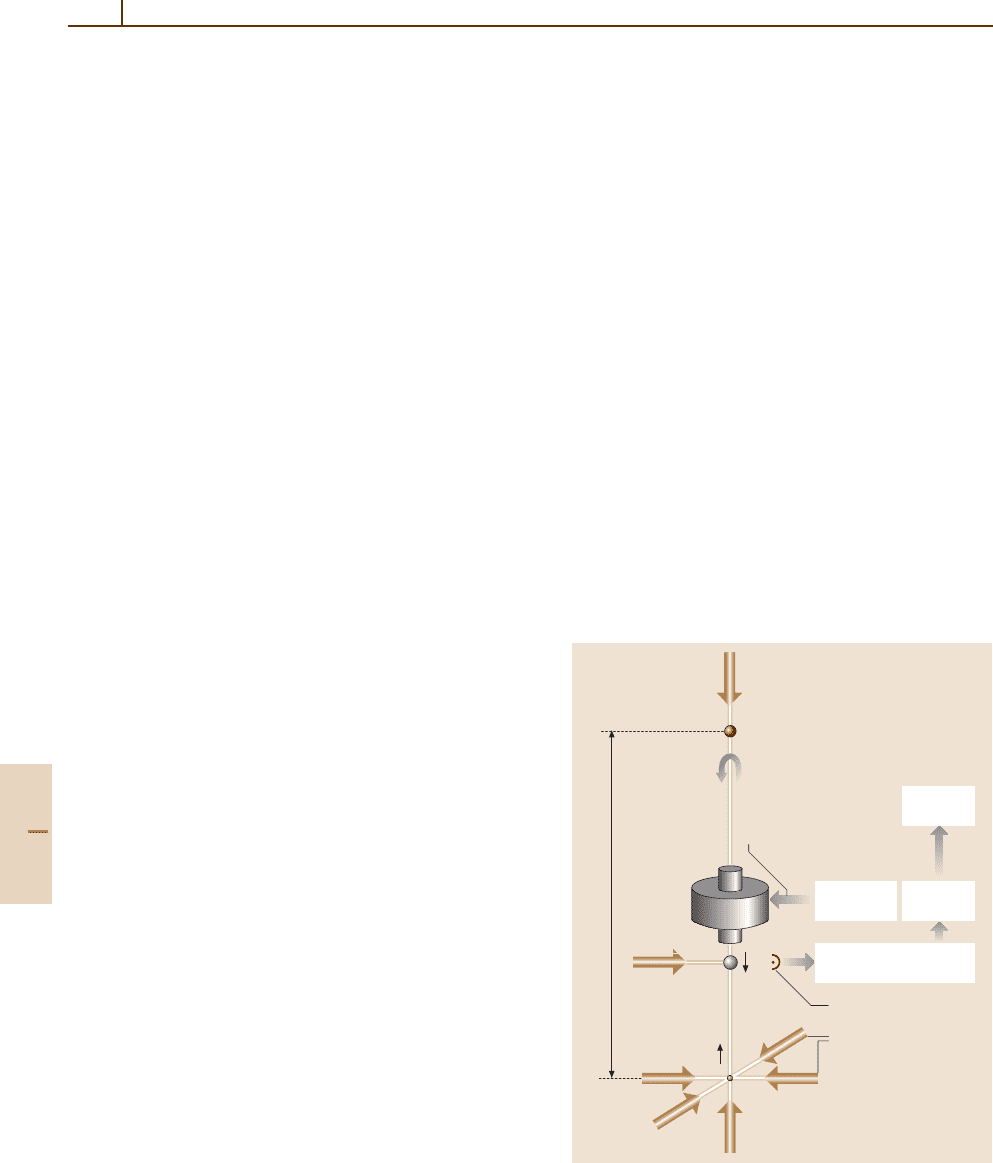
456 Part B Atoms
errors. While there is still potential for improvement,
the basic details of the method have been recently
fixed.
The most advanced atomic clocks are discussed
in Sect. 30.1. They are realized with many-electron
atoms and their frequency cannot be interpreted in terms
of fundamental constants. However, a much simpler
problem needs to be solved: to interpret their variation in
terms of fundamental constants. This idea is discussed
in Sect. 30.2. The current laboratory constraints on the
variations of the fundamental constants are summarized
in Sect. 30.3.
30.1 Atomic Clocks and Frequency Standards
Frequency standards are important tools for precision
measurements and serve various purposes which, in
turn, have different requirements that must be satis-
fied. In particular, it is not necessary for a frequency
standard to reproduce a frequency which is related to
a certain atomic transition although it may be expressed
in its terms. A well known example is the hydrogen
maser, where the frequency is affected by the wall shift
which may vary with time [30.5]. For the study of time
variations of fundamental constants it is necessary to
use standards similar to a primary caesium clock. In
this case, any deviation of its frequency from the un-
perturbed atomic transition frequency should be known
(within a known uncertainty) because this is a necessary
requirement for being a ‘primary’ standard.
From the point of view of fundamental physics, the
hydrogen maser is an artefact quite similar, in a sense,
to the prototype of the kilogram held at the Bureau
International des Poids et Mesures (BIPM) in Paris. Both
artefacts are somehow related to fundamental constants
(e.g., the mass of the prototype can be expressed in
terms of the nucleon masses and their number) but they
also have a kind of residual classical-physics flexibility
which allows their properties to change. In contrast, stan-
dards similar to the caesium clock have a frequency (or
other property) that is determined by a certain natural
constant which is not flexible, being of pure quantum
origin. It may change only if the fundamental constants
are changing.
In Sect. 30.3, results obtained with caesium and ru-
bidium fountains, a hydrogen beam, ultracold calcium
clouds, and trapped ions of ytterbium and mercury are
discussed. While caesium and rubidium clocks oper-
ate in the radio frequency domain, most of the other
standards listed above rely on optical transitions.
30.1.1 Caesium Atomic Fountain
Caesium clocks are the most accurate primary stan-
dards for time and frequency [30.6]. The hyperfine
splitting frequency between the F = 3andF = 4levels
of the
2
S
1/2
ground state of the
133
Cs atom at 9.192 GHz
has been used for the definition of the SI second since
1967. In a so-called caesium fountain (Fig. 30.1), a di-
lute cloud of laser cooled caesium atoms at a temperature
of about 1 µK is launched upwards to initiate a free
parabolic flight with an apogee at about 1 m above the
cooling zone. A microwave cavity is mounted near the
lower endpoints of the parabola and is traversed by the
atoms twice – once during ascent, once during descent
– so that Ramsey’s method of interrogation with sepa-
rated oscillatory fields [30.5] can be realized. The total
interrogation time being on the order of 0.5s, a res-
onance linewidth of 1 Hz is achieved, about a factor
of 100 narrower than in traditional devices using a ther-
mal atomic beam from an oven. Selection and detection
ν = 9 192 631 770 Hz ⫾ ∆
1 pair of vertical
laser beams
Clock
output
Quartz
oscillator
Microwave
synthesis
Electronics for
detection and control
Photodetector
2 pairs of horizontal
laser beams
Cold atoms:
T = 1–2 µΚ
Launching velocity = 4 m/s
Microwave
cavity
Detection
laser
Launching
height
Fig. 30.1 Schematic of an atomic fountain clock
Part B 30.1
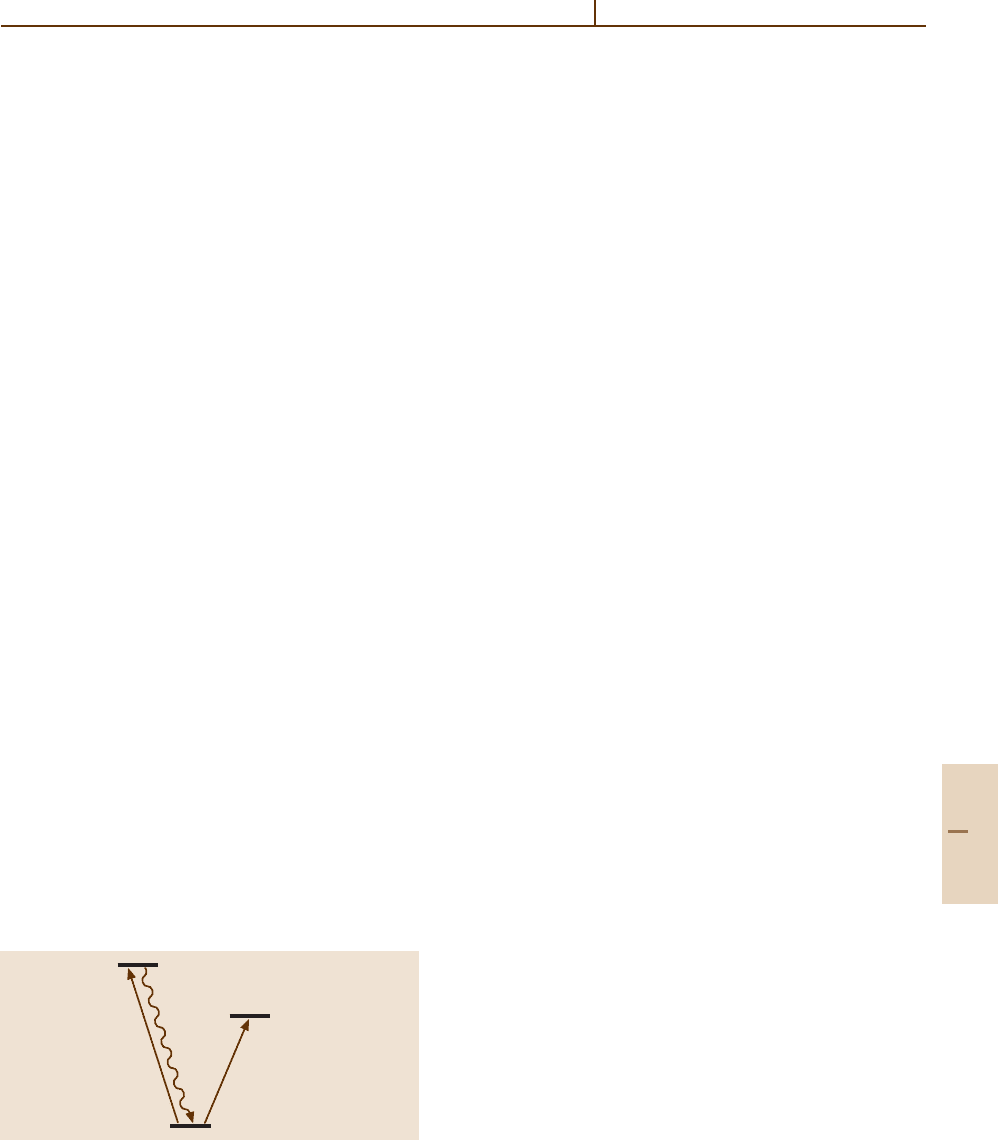
Atomic Clocks and Constraints on Variations of Fundamental Constants 30.1 Atomic Clocks and Frequency Standards 457
of the hyperfine state is performed via optical pumping
and laser induced resonance fluorescence. In a care-
fully controlled setup, a relative uncertainty slightly
below 1 × 10
−15
can be reached in the realization of
the resonance frequency of the unperturbed Cs atom.
The averaging time that is required to reach this level
of uncertainty is on the order of 10
4
s. One limiting
effect that contributes significantly to the systematic un-
certainty of the caesium fountain is the frequency shift
due to cold collisions between the atoms. In this re-
spect, a fountain frequency standard based on the ground
state hyperfine frequency of the
87
Rb atom at about
6.835 GHz is more favorable, since its collisional shift
is lower by more than a factor of 50 for the same atomic
density. With the caesium frequency being fixed by def-
inition in the SI system, the
87
Rb frequency is therefore
presently the most precisely measured atomic transition
frequency [30.7].
30.1.2 Single-Ion Trap
An alternative to interrogating atoms in free flight, and
a possibility to obtain practically unlimited interaction
time, is to store them in a trap. Ions are well suited be-
cause they carry electric charge and can be trapped in
radio frequency ion traps (Paul traps [30.8]) that provide
confinement around a field-free saddle point of an elec-
tric quadrupole potential. This ensures that the internal
level structure is only minimally perturbed by the trap.
Combined with laser cooling it is possible to reach the
so-called Lamb–Dicke regime where the linear Doppler
shift is eliminated. A single ion, trapped in an ultrahigh
vacuum is conceptually a very simple system that allows
good control of systematic frequency shifts [30.9]. The
use of the much higher, optical reference frequency al-
lows one to obtain a stability that is superior to micro-
wave frequency standards, although only a single ion
is used to obtain a correction signal for the reference
oscillator.
Metastable level
“Forbidden”
reference transition
Cooling transition
(dipole allowed)
Fig. 30.2 Double resonance scheme applied in single-ion-
trap frequency standards
A number of possible reference optical transitions
with a natural linewidth of the order of 1 Hz and be-
low are available in different ions, such as Yb
+
[30.10]
and Hg
+
[30.11, 12]. These ions possess a useful level
system, where both a dipole-allowed transition and a for-
bidden reference transition of the optical clock can be
driven with two different lasers from the ground state
(Fig. 30.2). The dipole transition is used for laser cooling
and for the optical detection of the ion via its reso-
nance fluorescence. If a second laser excites the ion to
the metastable upper level of the reference transition,
the fluorescence disappears and every single excitation
can thus be detected with practically hundred percent
efficiency as a dark period in the fluorescence signal.
Using these techniques and a femtosecond laser
frequency comb generator (see Sect. 30.1.5) for the link
to primary caesium clocks, the absolute frequencies
of the transitions
2
S
1/2
→
2
D
5/2
in
199
Hg
+
at 1065 THz
and
2
S
1/2
→
2
D
3/2
in
171
Yb
+
at 688 THz have been
measured with relative uncertainties of only 9 × 10
−15
.
It is believed that single-ion optical frequency standards
offer the potential to ultimately reach the 10
−18
level of
relative accuracy.
A similar double resonance technique can be em-
ployed if the reference transition is in the microwave
domain and a number of accurate measurements of
hyperfine structure intervals in trapped ions has been
performed. In particular, the HFS interval in
171
Yb
+
has
been measured several times [30.13–15] and can be used
to obtain constraints on temporal variations.
30.1.3 Laser-Cooled Neutral Atoms
Optical frequency standards have been developed
with free laser-cooled neutral atoms, most notably of
the alkaline-earth elements that possess narrow inter-
combination transitions. The atoms are collected in
a magneto-optical trap, are then released and in-
terogated by a sequence of laser pulses to realize
a frequency-sensitive Ramsey–Bordé atom interferom-
eter [30.16]. Of these systems, the one based on the
1
S
0
→
3
P
1
intercombination line of
40
Ca at 657 nm has
reached the lowest relative uncertainty so far (about
2×10
−14
) [30.11, 12, 17, 18]. Limiting factors in the
uncertainty of these standards are the residual lin-
ear Doppler effect and phase front curvature of the
laser beams that excite the ballistically expanding atom
cloud. It has therefore been proposed to confine the
atoms in an optical lattice, i. e., in the array of in-
terference maxima produced by several intersecting,
red-detuned laser beams [30.19]. The detuning of the
Part B 30.1
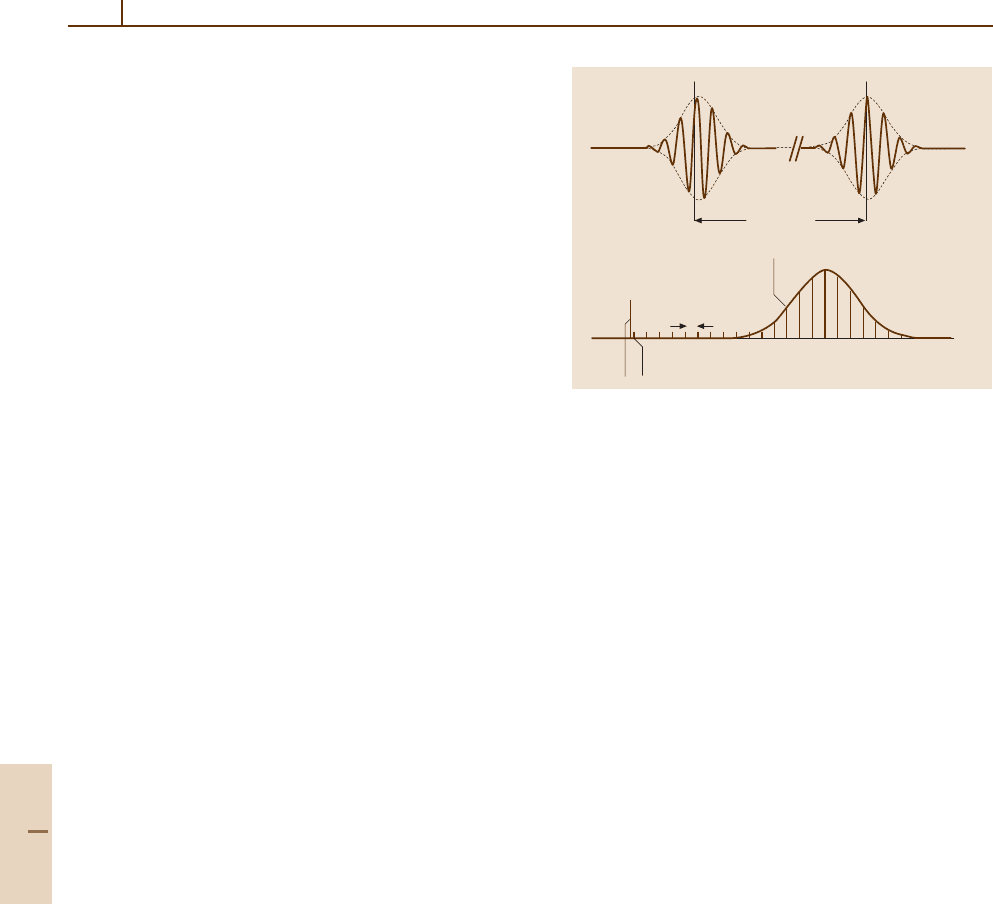
458 Part B Atoms
trapping laser could be chosen such that the light shift
it produces in the ground and excited state of the
reference transition are equal, and therefore it would
produce no shift of the reference frequency. This ap-
proach is presently being investigated and may be
applied to the very narrow (mHz natural linewidth)
1
S
0
→
3
P
0
transitions in neutral strontium, ytterbium,
or mercury.
30.1.4 Two-Photon Transitions
and Doppler-Free Spectroscopy
The linear Doppler shift of an absorption resonance can
also be avoided if a two-photon excitation is induced
by two counterpropagating laser beams. A prominent
example that has been studied with high precision is
the two-photon excitation of the
1
S →
2
S transition in
atomic hydrogen. The precise measurement of this fre-
quency is of importance for the determination of the
Rydberg constant and as a test of quantum electrody-
namics (QED). Hydrogen atoms are cooled by collisions
in a cryogenic nozzle and interact with a standing laser-
wave of 243 nm wavelength inside a resonator. Since
the atoms are not as cold as in laser cooled samples,
a correction for the second order Doppler effect is per-
formed. The laser excitation is interrupted periodically
and the excited atoms are detected in a time resolved
manner so that their velocity can be examined. An ac-
curacy of about 2 × 10
−14
has been obtained in absolute
frequency measurements with a transportable caesium
fountain [30.20, 21].
30.1.5 Optical Frequency Measurements
In recent years, the progress in stability and accuracy
of optical frequency standards has been impressive; and
there is belief that in the future an optical clock may
supersede the microwave clocks because the optical os-
cillators offer a much higher number of periods in a given
time. In addition, some systematic effects, such as the
Zeeman effect, have an absolute order of magnitude
that does not scale with the transition frequency, and
consequently is relatively less important at higher tran-
sition frequencies. A long-standing problem, however,
was the precise conversion of an optical frequency to the
microwave domain, where frequencies can be counted
electronically in order to establish a time scale or can
easily be compared in a phase coherent way.
This problem has recently been solved by the
so-called femtosecond laser frequency comb gener-
ator [30.22]. Briefly, a mode-locked femtosecond laser
Time
∆t = 1/f
r
Frequency
f
n
f
r
f = 0
f
ceo
Fig. 30.3 Frequency comb generated from femtosecond
laser pulses
produces, in the frequency domain, a comb of equally
spaced optical frequencies f
n
(Fig. 30.3) that can be
written as f
n
= nf
r
+ f
ceo
(with f
ceo
< f
r
), where f
r
is
the pulse repetition rate of the laser, the mode number
n is a large integer (of order 10
5
), and f
ceo
(carrier-
envelope-offset) is a shift of the whole comb that is
produced by group velocity dispersion in the laser. The
repetition rate f
r
can easily be measured with a fast
photodiode. In order to determine f
ceo
,thecombis
broadened in a nonlinear medium so that it covers at
least one octave. Now the second harmonic of mode
n from the “red” wing of the spectrum, at frequency
2(nf
r
+ f
ceo
), can be mixed with mode 2n from the
“blue” wing, at frequency 2nf
r
+ f
ceo
,and f
ceo
is ob-
tained as a difference frequency. In this way, the precise
relation between the two microwave frequencies f
r
and
f
ceo
and the numerous optical frequencies f
n
is known.
The setup can now be used for an absolute optical
frequency measurement by referencing f
r
and f
ceo
to
a microwave standard and recording the beat note be-
tween the optical frequency f
o
to be measured and the
closest comb frequency f
n
.Viceversa,thesetupmay
work as an optical clockwork, for example, by adjusting
f
ceo
to zero and by stabilizing one comb line f
n
to f
o
so that f
r
is now an exact subharmonic to order n of f
o
.
The precision of these transfer schemes has been investi-
gated and was found to be so high that it will not limit the
performance of optical clocks for the foreseeable future.
30.1.6 Limitations on Frequency Variations
The frequency standards described above have been suc-
cesfully developed and their accuracy has been improved
Part B 30.1
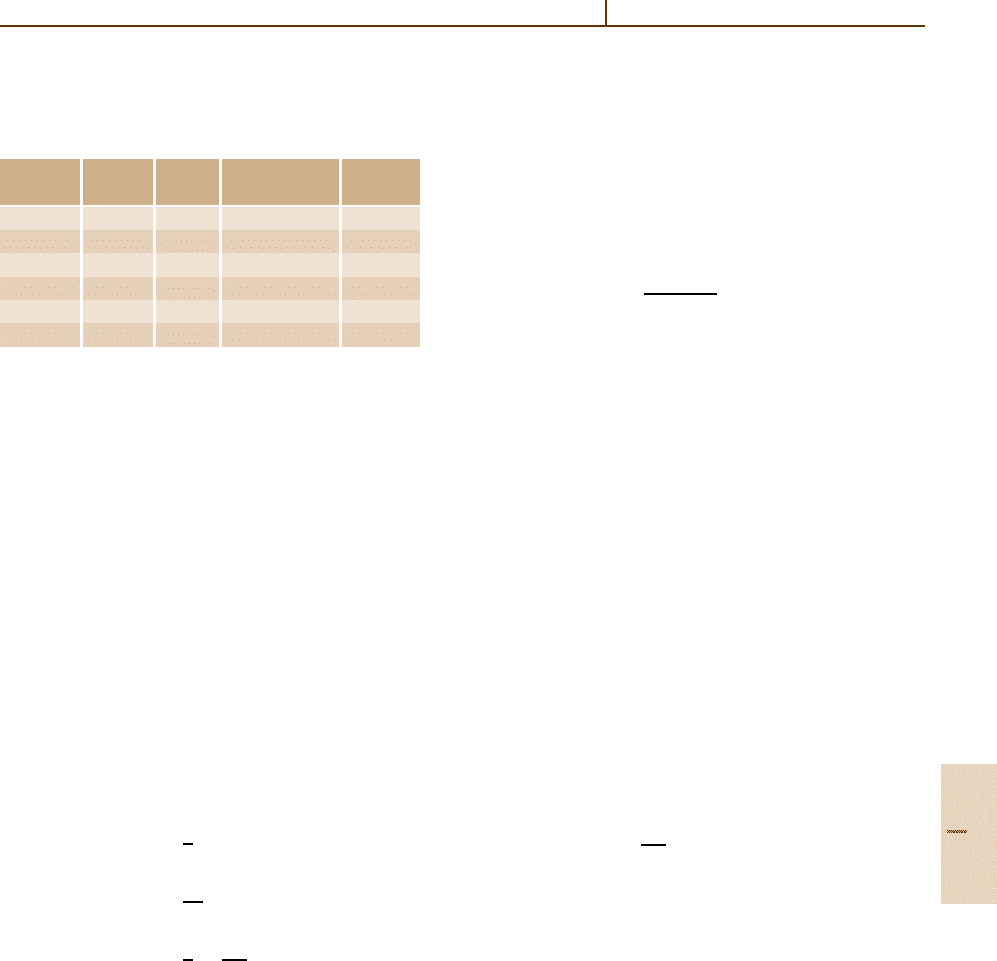
Atomic Clocks and Constraints on Variations of Fundamental Constants Atomic Spectra and Fundamental Constants 459
Table 30.1 Limits on possible time variation of frequencies
of different transitions in SI units. Here δ f/ f is the frac-
tional uncertainty of the most accurate measurement of the
frequency f
Atom, f δ f/ f f/t Ref.
transition
GHz (10
−15
) (Hz/yr)
H, Opt 2 466 061 14 −8 ± 16 [30.20, 21]
Ca, Opt 455 986 13 −4 ± 5 [30.17, 18]
Rb, HFS 6.835 1 (0 ±5) × 10
−6
[30.7]
Yb
+
,Opt 688 359 9 −1 ± 3 [30.23]
Yb
+
,HFS 12.642 73 (4 ± 4) × 10
−4
[30.13–15]
Hg
+
,Opt 1 064 721 9 0 ± 7 [30.11, 12]
in the last decade. This progress, as a consequence, has
led to certain constraints on the possible variations of
the fundamental constants. Considering frequency varia-
tions, one has to have in mind that not only the numerical
value but also the units may vary. For this reason, one
needs to deal with dimensionless quantities which are
unit-independent. During the last decade, a number of
transition frequencies were measured in the correspond-
ing SI unit, the hertz (see Table 30.1). These dimensional
results are actually related to dimensionless quantities
since a frequency measurement in SI is a measurement
with respect to the caesium hyperfine interval
f
= 9 192 631 770 ·
f
f
HFS
(Cs)
,
(30.1)
where
f
stands for the numerical value of the fre-
quency f . (Most absolute frequency measurements have
been realized as a direct comparison with a primary
caesium standard.) In Sect. 30.3, in order to simplify
notation, this symbol for the numerical value is dropped.
30.2 Atomic Spectra and their Dependence
on the Fundamental Constants
30.2.1 The Spectrum of Hydrogen
and Nonrelativistic Atoms
The hydrogen atom is the simplest atom and one can eas-
ily calculate the leading contribution to different kinds
of transitions in its spectrum [30.24, 25], such as the
gross, fine, and hyperfine structure. The scaling behav-
ior of these contributions with the values of the Rydberg
constant R
∞
, the fine structure constant α,andthemag-
netic moments of proton and Bohr magneton is clear.
The results for some typical hydrogenic transitions are
f(2p → 1s)
3
4
cR
∞
,
f
2p
3/2
− 2p
1/2
1
16
α
2
cR
∞
,
f
HFS
(1s)
4
3
α
2
µ
p
µ
B
cR
∞
. (30.2)
In the nonrelativistic approximation, the basic fre-
quencies and the fine and hyperfine structure intervals
of all atomic spectra have a similar dependence on the
fundamental constants. The presence of a few elec-
trons and a nuclear charge of Z = 1 makes theory more
complicated and introduces certain multiplicative num-
bers but involves no new parameters. The importance
of this scaling for a search for the variations was first
pointed out in [30.26] and was applied to astrophysical
data. Similar results may be presented for molecular
transitions (electronic, vibrational, rotational and hyper-
fine) [30.27], however, up to now no measurement with
molecules has been performed at a level of accuracy
that is competitive with atomic transitions. They have
been used only in a search for variations of constants in
astrophysical observations [30.28].
30.2.2 Hyperfine Structure
and the Schmidt Model
The atomic hyperfine structure
f
NR
(HFS) = const α
2
µ
µ
B
cR
∞
(30.3)
involves nuclear magnetic moments µ which are dif-
ferent for different nuclei; thus, a comparison of the
constraints on the variations of nuclear magnetic mo-
ments has a reduced value. To compare them, one may
apply the Schmidt model [30.3, 29], which predicts all
the magnetic moments of nuclei with an odd number of
nucleons (odd value of atomic number A)intermsof
the proton and neutron g-factors, g
p
and g
n
, respectively,
and the nuclear magneton only. Unfortunately, the un-
certainty of the calculation within the Schmidt model
is quite high (usually from 10% to 50%). The Schmidt
model, being a kind of ab initio model, only allows for
improvements which, unfortunately, involve some ef-
fective phenomenological parameters. This would not
Part B 30.2
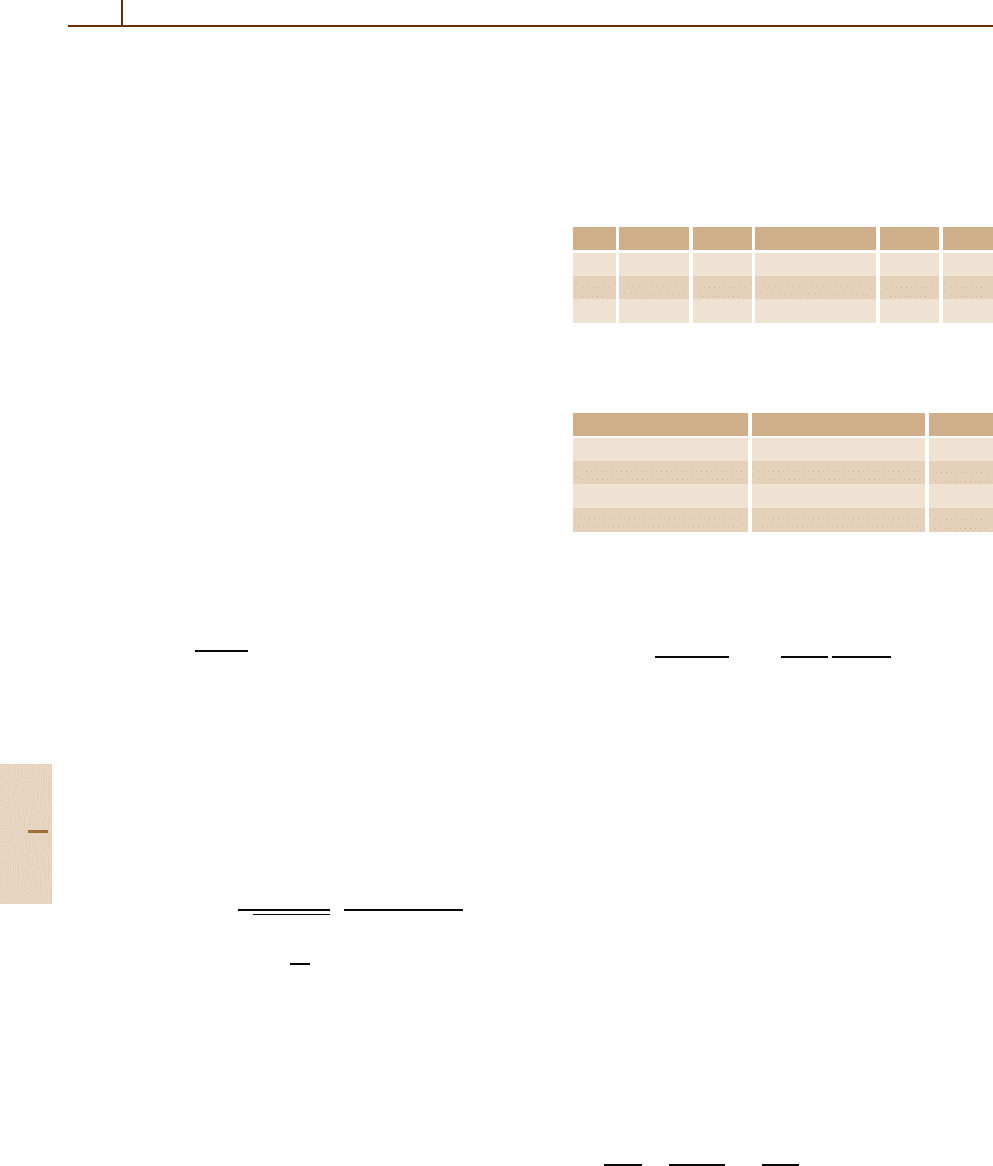
460 Part B Atoms
really improve the situation, but return us to the case
where there are too many possibly varying independ-
ent parameters. A comparison of the Schmidt values to
the actual data is presented for caesium, rubidium, and
ytterbium in Table 30.2.
30.2.3 Atomic Spectra:
Relativistic Corrections
A theory based on the leading nonrelativistic approxima-
tion may not be accurate enough. Any atomic frequency
can be presented as
f = f
NR
F
rel
(α) , (30.4)
where the first (nonrelativistic) factor is determined by
a scaling similar to the hydrogenic transitions (30.2).
The second factor stands for relativistic corrections
which vanish at α = 0; and thus, F
rel
(0) = 1.
The importance of relativistic corrections for the
hyperfine structure was first emphasized in [30.30].
Relativistic many-body calculations for various tran-
sitions have been performed in [30.31–36]. A typical
accuracy is about 10%. Some results are summarized
in Tables 30.2 and 30.3, where we list the relative
sensitivity of the relativistic factors F
rel
to changes in α,
κ =
∂lnF
rel
∂lnα
.
(30.5)
Note that the relativistic corrections in heavy atoms are
proportional to (Zα)
2
because of the singularity of rela-
tivistic operators. Due to this, the corrections rapidly
increase with the nuclear charge Z.
The signs and magnitudes of κ are explained by
a simple estimate of the relativistic correction. For
example, an approximate expression for the relativis-
tic correction factor for the hyperfine structure of an
s-wave electron in an alkali-like atom is [30.30]
F
rel
(α) =
1
1 − (Zα)
2
·
1
1 − (4/3)(Zα)
2
1 +
11
6
(Zα)
2
.
Table 30.2 Magnetic moments and relativistic corrections
for atoms involved in microwave standards. The relativis-
tic sensitivity κ is defined in Sect. 30.2.3.Hereµ is an
actual value of the nuclear magnetic moment, µ
N
is the nu-
clear magneton, and µ
S
stands for the Schmidt value of
the nuclear magnetic moment; the nucleon g factors are
g
p
/2 2.79 and g
n
/2 −1.91
Z Atom µ/µ
N
µ
S
/µ
N
µ/µ
S
κ
37
87
Rb 2.75 g
p
/2 + 1 0.74 0.34
55
133
Cs 2.58 7/18 · (10 − g
p
) 1.50 0.83
70
171
Yb
+
0.49 −g
n
/6 0.77 1.5
Table 30.3 Limits on possible time variation of the fre-
quencies of different transitions and their sensitivity to
variations in α due to relativistic corrections
Atom, transition ∂ f/ f∂t κ
H, 1s − 2s − 3.2(63) ×10
−15
yr
−1
0.00
40
Ca,
1
S
0
−
3
P
1
−8(11) ×10
−15
yr
−1
0.03
171
Yb
+
,
2
S
1/2
−
2
D
3/2
− 1.2(44) ×10
−15
yr
−1
0.9
199
Hg
+
,
2
S
1/2
−
2
D
5/2
− 0.2(70) ×10
−15
yr
−1
−3.2
A similar rough estimation for the energy levels may be
performed for the gross structure:
E =−
Z
2
a
mc
2
α
2
2n
2
∗
1 +
(Zα)
2
n
∗
1
j + 1/2
.
(30.6)
Here j is the electron angular momentum, n
∗
is the
effective value of the principle quantum number (which
determines the nonrelativistic energy of the electron),
and Z
a
is the charge “seen” by the valence electron – it
is 1 for neutral atoms, 2 for singly charged ions, etc. This
equation tells us that κ, for the excitation of the electron
from the orbital j to the orbital j
, has a different sign
for j > j
and j < j
. The difference of sign between the
sensitivities of the ytterbium and mercury transitions in
Table 30.3 reflects the fact that in Yb
+
a 6s-electron is
excited to the empty 5d-shell, while in Hg
+
a hole is
created in the filled 5d-shell if the electron is excited to
the 6s-shell.
30.3 Laboratory Constraints on Time the Variations
of the Fundamental Constants
Logarithmic derivatives (30.5) appear since we are look-
ing for a variation of the constants in relative units.
In other words, we are interested in a determination of,
e.g., ∆α/α∆t while the input data of interest are related
to ∆ f/ f∆t. Their relation takes the form
∂ln f
∂t
=
∂ln f
NR
∂t
+ κ
∂lnα
∂t
.
(30.7)
Part B 30.3
